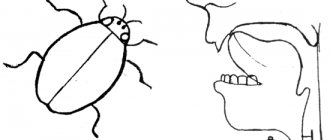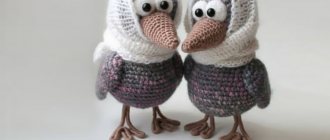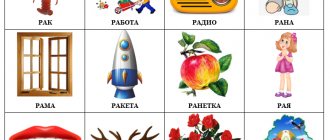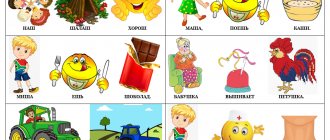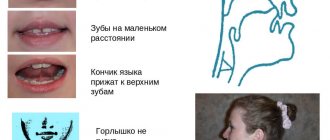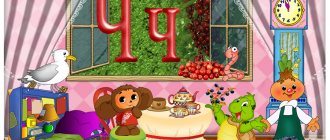Correct articulation
Any work begins with the child being shown a sound sample. The sound [K] belongs to the group of back-lingual sounds, that is, to pronounce them, the back of the tongue rises. It is from this sound that the rest - [X], [G] and their soft pairs - are made.
Therefore, it is advisable to start the correction with the sound [K]. To pronounce it, the lips take a neutral position or become open. The teeth are open, the tip of the tongue lies at the lower teeth, but does not rest against them. The front and middle backs are lowered, the back ones are raised and rest against the soft palate. The sides of the tongue lightly touch the hard palate. The vocal cords do not tense, the air passes through the closure of the tongue and palate, breaks it and the sound [K] is produced.
Normally, the posterior lingual group appears at an early age. Thanks to sucking, the tongue takes the form of a “slide” and the child is able to pronounce individual sounds.
Difficulties may arise due to a high or narrow palate - in this case, it will not be possible to form a bow. With dysarthria, weakness or tension of individual muscles of the tongue occurs. Sometimes children have poor phonemic hearing. Thanks to it, people distinguish between different speech sounds.
Phonemic (speech) hearing should not be confused with physical hearing! If the first is violated, the child will be able to distinguish non-speech sounds well and respond to the speech of other people, but will poorly perceive what he himself says.
Defective pronunciation of the sound [K] is called kappacism. Sometimes there is no sound, then instead of “Cat” you get “'ot”. The sound may be distorted and a click will be heard instead - this happens due to the bow being too tight.
Replacing [K] with other sounds is called paracappacism. Most often the sound changes to [G], [X] and sometimes to [T]. In this case, in addition to sound production, the speech therapist deals with differentiation.
Disturbances in the reproduction of phonemes K and Kь
Speech therapy divides errors in the pronunciation of the hard and soft sound K into 3 groups with characteristic types of deviations from the norm. Presented in the table:
| Name | Type of violation | Characteristic |
| Kappacism | Lack of correct sound reproduction. | The phoneme is replaced by a click of the vocal cords. |
| Letter distortion. | Nasal playback (occurs due to improper breathing). Lateral pronunciation is typical for children with incorrect articulation or the presence of organic defects. | |
| Complete absence of “K” and “K” in conversation. | The child systematically misses a letter in words (Kit - It, Cube - Ub). | |
| Paracapacism | Replacing "K" with "T". Cat - Thoth, Cube - Tub. | |
| Replacing "K" with "X". Kit – Hit, Com – Hom. | ||
All of the listed types of deviations are united by specialists into one concept - dyslalia (more about that here). The diagnosis also includes various defects in the pronunciation of voiced and voiceless consonants. The exception is vowel sounds. They are pronounced correctly when dislali.
Expert opinion
Margarita Sergeevna S.
Speech pathologist and speech pathologist with 15 years of experience working in various speech correction centers with children of different ages.
Important: if you do not work with your child at an early stage of detecting a problem before school, this can lead to the development of dysgraphia (writing errors) and dyslexia (reading errors). Correction in school-age children requires much more time and the mandatory intervention of a speech therapist.
Important Rules
Before you start producing any sound, you need to understand some points. You can’t try to “skip” one stage and move on to the next. In this case, it will not be possible to correct the defect.
It is necessary to devote time to articulation and breathing exercises. Dynamic exercises are performed to a count of ten, static exercises to a count of five. Execution rules:
- strictly in front of the mirror;
- The child’s attention is focused on the correct posture;
- do it every day.
With dysarthria, it may take several months to practice the correct movements. There is no need to rush into staging. In severe cases, drug therapy is used to correct increased or decreased tone. Physiotherapy can also help speed up the process.
Structure of a lesson on automating sounds [K] and [G]
After setting the phonemes [K] and [G], it is necessary to begin their automation. Classes for each sound are conducted separately. The first to automate is [K], and after entering it into coherent speech, they move on to automating [G].
Each lesson is focused on the implementation of several groups of tasks.
Educational:
- Clarification of ideas about the method of reproducing an automated phoneme separately, in syllables, phrases, independent speech.
- Introducing the terms sound, syllable, word, sentence.
- Teaching basic reading skills.
- Increasing vocabulary on a specific lexical topic.
Educational:
- Improving the motor activity of the speech organs.
- Formation of sensory perception of articulatory position.
- Improving phonemic processes.
- Developing the ability to perform sound-letter analysis using graphic images.
- Improving non-speech mental processes.
Educational:
- Stimulating interest in the activity.
- Developing perseverance, determination, and an adequate attitude towards one’s speech disorders.
Corrective:
- Correction of incorrect position of automated sound.
- Elimination of speech negativism.
Preparatory stage
Before you start producing sound, you need to develop a base for it. This is articulation and breathing. Speech therapy adopts a step-by-step approach to correcting sound pronunciation. Consistency must not be neglected, otherwise the defect will not be corrected.
The purpose of the preparatory stage in eliminating cappacism is to teach the child to feel the movements of the tongue. A number of exercises are proposed for this.
Articulation gymnastics is always performed in front of a mirror. This is how children develop visual control.
The first exercise is called “Strongman”. The child opens his mouth and smiles widely. The speech therapist wraps the finger in a scarf or bandage and places it on the tip of the tongue, which lies relaxed near the lower teeth. He begins to carefully move the organ deeper into the mouth. At this time, the child resists and pushes out his finger.
The next stage is to place a finger on the middle part of the tongue, moving it deeper into the mouth. Gradually, the preschooler will develop a new sensation; he will be able to move his tongue independently.
The second exercise is “Slide”. The speech therapist shows a sample of performance in front of the mirror. A wide smile with an open mouth. The tip of the tongue rests on the lower teeth, the back part is raised towards the palate. If the child has difficulty, you can help him press the tip.
The third exercise is “Kneading the dough.” Designed to relieve tone and relax. The wide tongue is placed on the lower lip, then lightly slapped with the upper lip.
In order to teach a preschooler to make his tongue wide, use the “Spatula” exercise. The mouth is open, the tongue is protruded and spread on the lower lip. The pose is held for five seconds.
Another way to strengthen your tongue muscles. The child sticks out his tongue, the speech therapist wraps it in a scarf, carefully holds the organ, and the preschooler tries to put it in his mouth.
To develop correct articulation, breathing exercises are used. To do this, they suggest the “Breeze” exercise. The child must make a “Gorochka”, and then blow the piece of paper or candy wrapper from the speech therapist’s hand.
To practice “Gorochka”, you are given a small syringe to chew. It is washed thoroughly and a large part is placed in the mouth. The pear will be pressed against the tip of the tongue, and the child will be asked to chew it lightly.
With a strong gag reflex, training is carried out gradually. The tongue is stroked with a probe to produce the sound [P], gradually moving further and further. You can stroke the upper palate with the ball, gradually moving towards the root of the tongue.
In severe cases, speech therapy massage helps. It can be manual or probe. It can only be prescribed by a specialist.
Stage II of work (conducted as a whole lesson)
Subject . Clarification of the pronunciation of the sound k.
Target . Achieve a clear, correct pronunciation of the sound k in onomatopoeia. Previous work. The movements of the tongue necessary for the correct pronunciation of sounds were clarified.
Preparatory work. The teacher prepares toys or pictures (chicken, rooster, sparrow, cuckoo, frog). Checks again how the children pronounce the sound k to find out who needs more attention.
The story “Who is screaming?” Short description
The teacher, turning to the children, says: “Remember, children, how you and I went for a walk in the forest at the dacha? We were going for a walk. We went out into the yard, and a chicken comes towards us (takes out a toy, puts it on the table) and shouts: “ko-ko-ko...” How does she scream? (“Ko-ko-ko.”) We move on, and the hen cackles: “Ko-ko-ko.” How does she cackle? (“Where, where.”) “Into the forest,” we answered her and moved on. A rooster sits on the fence (takes out the rooster) and shouts: “kuka-re-ku!” How does the rooster crow? (“Ku-ka-re-ku!”) We went further along the road, past the vegetable garden. We look, and the sparrows are pecking at the grains of the sunflowers (he takes out the sparrow). The children chased them away. How did you drive them away? (“Shoot-shoot.”) We came to the forest. It's good there. We started collecting flowers, and suddenly we heard a cuckoo cuckoo (takes out the cuckoo): “cuckoo.” How does a cuckoo crow? (“Ku-ku…”) We picked a lot of flowers and went back. We hear frogs croaking (takes out a frog): “kva-kva.” How do frogs croak? (“Kva-kva.”) We walked in the forest and returned home.”
Then the teacher asks the children who they saw and who shouted how. Methodical instructions. Make sure that in onomatopoeia children pronounce the sound k clearly and answer questions with complete answers.
Staging methods
Sound production takes place in individual lessons. The first way is by imitation. To do this, the speech therapist shows a sample of articulation, but does not pronounce the sound itself. He just demonstrates how the tongue forms a “mound” and invites the preschooler to repeat. Then they place a cotton ball on his palm and ask him to blow it off. The output will be the correct sound [K], which can be automated.
But it is rarely possible to introduce sound by imitation, so mechanical assistance is used. The Rau probe set includes a special probe for back-lingual sounds. It looks like a wide spatula.
The preschooler continuously pronounces the syllable “TA”, while the speech therapist uses a probe to push his tongue deep into his mouth. After the manipulation, the desired sound will be heard. The probe is held so that the child remembers the pronunciation.
At this point, it is necessary to come up with a designation for the sound. You cannot call it [K], as this will cause the old pronunciation stereotype. “Cough” will do.
The probe is removed and the child is asked to independently reproduce “Cough”. You will have to help a little with the probe so that the preschooler can find the correct position for the tongue. They switch to automation only when there is ideal sound in an isolated position.
You can try to set the sound from the imitation. The speech therapist coughs quietly, producing something like [CHE]. This should be done quietly, almost in a whisper, reducing the gap between coughs. This trick will remove the [X] sound. For visualization, ask the child to bring his palm to his mouth. He will feel the shock of air.
There is also a way to perform it while inhaling. For this purpose, the preschooler is taught to retract his tongue, to collect it like “a snail hiding in its shell.” The tip is placed on the lower lip, slides sharply along the lower part of the mouth and folds into a “peacock”. The speech therapist whispers something similar to “KA”.
From the same “snail in the shell” position, the child pronounces “KA” - he is asked to “let the snail out.” Such a deceptive maneuver will cause an isolated sound and show a new position.
Producing the sound [K] when replacing it with [T] is most effectively done with mechanical assistance. As a substitute for the probe, use a regular spatula or a baby silicone pacifier.
Staging with support
In some situations, [K] can be called from the correct sound. If there is a good [X], then you can try from him. To do this, the child’s attention is focused on the peculiarities of pronunciation - the root of the tongue touches the palate, you need to remember this sensation. You need to press the tip well into the sky, as if to close the “gap” with your tongue, the pressure should be strong. At this moment you need to “cough” and you will get the sound [K].
Then they begin to train the child to pronounce [K] in isolation. The sound can be loud, explosive, intense. In this case, you need to ask him to speak in a whisper. The sound will go away over time.
In order to consolidate the isolated sound, you need to use gaming techniques. The preschooler is asked to sort through glass pebbles, laying them out in the form of a path. Then the fingers “walk” along them, each step is a sound.
Different paths are suitable: those that need to be traced with a finger, laying out patterns, painting over pictures. Children like dynamic games: jump as many times as the sound sounds. You can lay out the track from different positions. Each jump is a change of pose. For example, he jumped and turned to the right, then to the left, etc. Each movement is accompanied by a sound.
Normal articulation for the sounds K and Kь
When pronouncing the phoneme “K”, the organs of the speech apparatus take the following position:
- The lips are opened in accordance with the following vowel sound.
- The tip of the tongue is behind the lower teeth. The organ does not touch the teeth, but is located closer to the middle of the oral cavity.
- The middle of the tongue is lowered.
- The back of the organ focuses on the soft part of the palate. The edges on the sides slightly touch the hard palate.
- The soft palate is raised. It should block the passage into the nasal cavity.
- Vocal cords in a relaxed state;
- Air through the mouth.
The articulation of the sound “Кь” suggests the following features:
- The corners of the lips are pulled back.
- Lips pressed to teeth.
- The tip of the tongue focuses on the lower incisors.
- The middle of the tongue is raised. It touches the middle of the hard palate.
Visual demonstration in the picture:
Progress of the lesson on automation of sounds [K] and [G]
The lesson must be carried out using a mirror. You need to start with an analysis of the articulation of the phoneme. They use a variety of visual aids: picture plan, speech therapy profile, hand model, dummies. The child examines the position of the participating organs of the speech apparatus and determines the nature of the air flow. After analyzing the articulation, you need to characterize the phoneme according to the following plan: vowel/consonant (is there an obstacle to the exhaled air flow), voiceless/voiced (is the voice involved), hard/soft (is there an additional rise in the middle part of the lingual back).
Next, the pronunciation of the sound is practiced. Explosive [K] and [G] are worked on with a quick exhalation. For reinforcement, games with elements of onomatopoeia (what the sound is like) are used. Then you need to introduce the child to the letter indicating the phoneme [K] or [G]. Each time the child comes to the conclusion that the sound is heard and pronounced, and the letter can be seen, read, and written. Finds objects in the surrounding reality that are similar in appearance to a letter. If necessary, correct spelling is practiced. Non-graphic and graphic exercises are used, aimed at developing the skill of correctly depicting a letter.
After becoming familiar with the letter, they begin to improve phonemic processes. The child learns to isolate a sound from a number of phonemes that are similar in acoustic-articulatory characteristics, from a stream of syllables, from a list of words (the teacher compiles a set of words on the corresponding topic), and determines the presence and position of an automated sound in a word. If the level of speech development is insufficient, phonemes that are distant in their acoustic-articulatory characteristics are offered.
Next, the phoneme is fixed in syllables. The child repeats after the adult, pronounces in parallel with him and himself lists the syllables with the assigned phoneme. According to this principle, forward and backward syllables, as well as with a combination of consonants, are fixed. The voiced phoneme [G] is not fixed on the material of reverse syllables due to its deafening.
When the phoneme is accurately reproduced separately, you can move on to working on it in words. It is important to carry out only after isolated fastening. Words are selected by a speech therapist taking into account the lexical topic of each lesson. The child pronounces the word and indicates the place of the phoneme in it. Older preschoolers do a sound-syllable analysis with a graphic diagram of one word according to plan: the first and last sound are highlighted, the number of vowels and consonants is counted, all sounds are named one by one. Under each letter a colored chip is placed to indicate the sound.
Automation of the sound [G] in words ending in [G] is not carried out due to deafening.
Then they practice the correct sound in the phrase. The child constructs sentences with the words he has learned. Older preschoolers analyze the sentence: explain the definition; voice the basic rules of writing, establish the order of words, and count their number. A sound-syllable analysis of each word is performed separately. When practicing phonemes in a phrase, pure tongue twisters and tongue twisters are used, selected according to the lexical topic. Tongue twisters are great for the most successful reinforcement of phonemes. In addition, with the help of tongue twisters you can practice clear, precise diction.
At the final stage of automation of any phoneme, one should begin to consolidate it in coherent speech. The text is selected according to the child’s age, taking into account the lexical topic. The child is offered a text of 5-6 sentences, rich in words with the sound being studied. It is advisable to use excerpts from fairy tales, stories, and children's poems. The speech therapist or child reads the text, then selects words with an automated sound from the composition.
The structure of each automation lesson includes one or two dynamic breaks. Their time and place are determined taking into account the child’s condition and the degree of his fatigue. At the end of each lesson, the child receives homework. After automating the sound [K] in the text, automation [G] is carried out in a similar manner. Automation of the sound [Кь] and [Гь] is similar. The final stage of work on these phonemes is their differentiation.
Didactic exercises for automating the sounds [K] and [G]
Phonemes should be automated in play activities using a variety of visual aids. For each sound position in a word, about thirty images should be selected. For complete successful automation, show the child a card index of about a hundred pictures.
Effective results can only be achieved if classes are emotionally positive. The child should not just look at and name the objects depicted in the pictures, but play.
It is imperative to take into account words that are rarely used in everyday life. The meaning of new words must be explained in a language that is simple and understandable to the child, taking into account his individual and age characteristics.
Sample exercises:
- Together with an adult and independently name what is shown in the picture.
- Listen to how many times the adult repeated the sound and say one more. You can pronounce syllables and words in the same way.
- Remember what is drawn and reproduce from memory. Gradually the number of images increases.
- Divide words into syllables.
- Determine the stressed syllable.
- Select images with the required number of sounds and name them.
- Determine what place the automated phoneme occupies in words, select images with a sound that occupies a certain position in the word.
- Make a sound-syllable analysis of words.
- Change nouns by case.
- Count objects with an automated phoneme in forward and reverse order.
- Select nouns for the pronouns my, mine, mine, mine, and pronounce the resulting phrases.
- Select adjectives for nouns, pronounce phrases.
- Finish the phrase started by an adult using the sound being studied.
- Match verbs to nouns and pronounce the resulting phrases.
- Form nouns with diminutive suffixes.
- Form relative adjectives.
- Compose stories based on plot pictures using leading questions, supporting words, and a given beginning or ending.
- Come up with questions for images, texts, and answer them.
Games for automating the sounds [K] and [G]
The fourth one is extra. The child looks at four pictures. Three of them depict objects with an automated phoneme, one does not. The child names pictures, clearly articulates the assigned phoneme, and names an object that does not have a given sound. You can search for images where the location of the phoneme is different.
Suitable - not suitable . Look at the picture of the refrigerator, clarify its purpose, and list what can be stored in it. By looking at object pictures with a fixed phoneme, decide whether it is possible or not to store this object in the refrigerator.
Box. Show the child the doll, tell him that the doll likes to look at pictures and put them in a box. Ask the doll to look at its pictures together and name them, clearly articulating the desired sound. Magic colors. Draw an open box of paints on a piece of thick paper. Place stacks of colored mugs with pictures on the back on top of the paints. Explain that these are magical colors in which the pictures are hidden. The child’s task is to find and name them.
Lunch for a gnome . Look at the image of a plump gnome. Speculate why he is plump. Offer to come up with what he likes to eat. Words must have an automated sound. You can draw a skinny gnome and offer to feed him.
